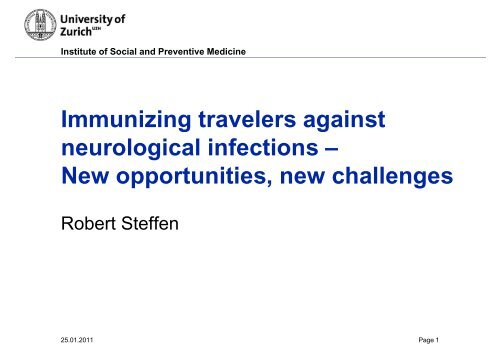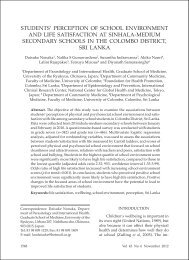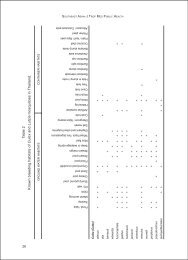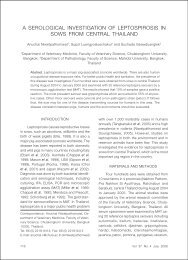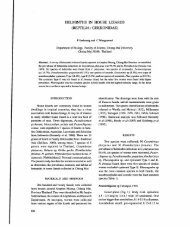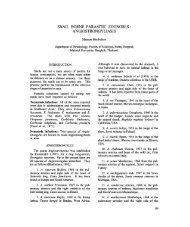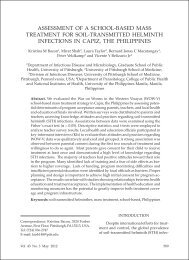Immunizing - Faculty of Tropical Medicine, Mahidol University
Immunizing - Faculty of Tropical Medicine, Mahidol University
Immunizing - Faculty of Tropical Medicine, Mahidol University
Create successful ePaper yourself
Turn your PDF publications into a flip-book with our unique Google optimized e-Paper software.
Institute <strong>of</strong> Social and Preventive <strong>Medicine</strong><br />
<strong>Immunizing</strong> travelers against<br />
neurological g infections –<br />
New opportunities, new challenges<br />
Robert Steffen<br />
25.01.2011 Page 1
Conflicts <strong>of</strong> interest<br />
I have or had within the past ffew years financial f relationships (grants ( for f<br />
research or to attend meetings, paid lectures, advisory boards) relevant<br />
to my presentation with:<br />
� Vaccines Drugs<br />
�� Bavarian Bavarian-Nordic Nordic DrFalk Pharma<br />
� Baxter Optimer<br />
� Crucell / Johnson & Johnson Roche<br />
� GlaxoSmithKline Santarus<br />
� Intercell Salix<br />
�� Novartis Vaccines & Diagnostics<br />
� San<strong>of</strong>i Pasteur McDonald‘s<br />
� SBL Vaccin Swiss International Air Lines<br />
25.01.2011 <strong>University</strong> <strong>of</strong> Zurich, BKK_Neurological, Robert Steffen Page 2
Rare: Rare: 1% <strong>of</strong> patients<br />
N Engl J Med 2006;354:119 2006;354:119-30 30<br />
25.01.2011 <strong>University</strong> <strong>of</strong> Zurich, BKK_Neurological, Robert Steffen<br />
Page 3
Travel-related diseases <strong>of</strong> the nervous system:<br />
Non-infectious: more frequent!<br />
�� Adverse events (neuropsychiatric)<br />
– Mefloquine and other antimalarials, vaccines (e.g. YF)<br />
– Repellents, insecticides (infants)<br />
– RRecreational ti l ddrugs<br />
� Nutritional poisoning, e.g. Ciguatera<br />
�� EEnvironmental i t l<br />
– Acute mountain sickness � cerebral edema<br />
– Divingg � decompression p sickness<br />
� Motion sickness<br />
� Pressure palsies (post-flight)<br />
� Jet-lag exacebates tension headache<br />
� Sleepp deprivation, p jet-lag j g � seizure<br />
Hill DR. J Travel Med 2000;7:259-66<br />
Potasman I et al. J Travel Med 2000;7:5-9<br />
Toovey SS. Travel Med Infect Dis 2009;7:2 2009;7:2-66<br />
Wilder-Smith EP & Wilder-Smith A in <strong>Tropical</strong> Diseases in Travelers, Schwartz E. ed., Wiley-Blackwell, 2009<br />
25.01.2011 <strong>University</strong> <strong>of</strong> Zurich, BKK_Neurological, Robert Steffen<br />
Page 4
Epidemiology p gy <strong>of</strong> viral travel-related<br />
infectious diseases <strong>of</strong> the nervous system<br />
Vaccine preventable<br />
– Rabies<br />
– Japanese encephalitis<br />
– Tick-borne encephalitis<br />
– Poliomyelitis<br />
– (Measles)<br />
– (Influenza)<br />
Other<br />
– West Nile Virus (WNV) infections<br />
– Rift Valley Fever (RVF)<br />
– TToscana Vi Virus iinfections f ti<br />
– Dengue fever<br />
– Etc Etc., etc etc.<br />
25.01.2011 <strong>University</strong> <strong>of</strong> Zurich, BKK_Neurological, Robert Steffen<br />
Page 5
Rabies in Belfast, Northern Ireland<br />
25.01.2011 <strong>University</strong> <strong>of</strong> Zurich, BKK_Neurological, Robert Steffen<br />
Page 6
Rabies<br />
� Transmitted by bites Areas at risk <strong>of</strong> rabies 1<br />
or scratches<br />
– 55’000 deaths/year<br />
– India greatest risk<br />
– Most human deaths<br />
following a dog bite<br />
– 30 to 60% in children<br />
aged
Particular risk for rabies<br />
DDestination: ti ti<br />
India (15’000-20’000�)<br />
( )<br />
Particularly, travel related:<br />
- Children*<br />
- Bicycle*/motorbike y<br />
riders<br />
- Trekkers, hikers* (e.g. Nepal)<br />
- Prolonged stay stay*<br />
- Pr<strong>of</strong>essionals with exposure*<br />
- Spelunkers*<br />
Spelunkers<br />
* WHO: International Travel and Health, Geneva 2010,<br />
Chapter 66, pp 119 119-25 25<br />
25.01.2011 <strong>University</strong> <strong>of</strong> Zurich, BKK_Neurological, Robert Steffen<br />
Page 8
Potential rabies exposure in travelers<br />
�� UU.S. S Peace Corps: PEP in 44.4% 4% per year<br />
Bernard K & Fishbein DB. Vaccine 1991;9:833-6<br />
� Swiss expatriates: 1.8% per year<br />
Hatz CF et al. Vaccine 1995;13:811-5<br />
� Nepal: 0.19 (tourists) to 0.57 (expatriates)/year<br />
Pandey P et al. J Travel Med 2002;9:127-31<br />
� Risk perception, French: 6.7%<br />
Altmann M et al. J Travel Med 2009;16:107-11<br />
25.01.2011 <strong>University</strong> <strong>of</strong> Zurich, BKK_Neurological, Robert Steffen<br />
Page 9
Rabies in dogs imported from from....<br />
�� Iraq: ‚animal rescue operation’<br />
CDC. MMWR 2008;57:1076-8 ;<br />
�� Morocco: various cases<br />
Eurosurveillance 2008;13 (11)<br />
Eurosurveillance 2004;8 (36)<br />
25.01.2011 <strong>University</strong> <strong>of</strong> Zurich, BKK_Neurological, Robert Steffen<br />
Page 10
Rabies immunization recommendations<br />
„Pre-exposure prophylaxis for those planning a visit to<br />
rabies endemic country, y, especially p y if the visited area is far<br />
from urban centres, where...“<br />
„Rabies pre-exposure vaccine should generally be given to<br />
adults and children who are at risk <strong>of</strong> rabies including those<br />
� travelling to remote areas where medical care is not readily available<br />
� undertaking higher risk activities (e.g. cycling, running)<br />
� travelling for long periods through rabies endemic countries<br />
� at occupational risk e.g. vets, animal handlers, and laboratory...“<br />
„... rabies vaccine may be recommended based on<br />
� local incidence,<br />
� ... availability <strong>of</strong> appropriate anti-rabies biologicals,<br />
� intended activity and<br />
� duration <strong>of</strong> stay / repeat travel...“<br />
25.01.2011 <strong>University</strong> <strong>of</strong> Zurich, BKK_Neurological, Robert Steffen<br />
Page 11
Basics on Japanese encephalitis (JE)<br />
� Mosquito-borne flavivirus<br />
�� Th The lleading di cause <strong>of</strong> f viral i l<br />
neurological infection and<br />
disability in Asia1 disability in Asia<br />
� 35,000–50,000 symptomatic<br />
cases reported epo ed eac each yea year<br />
among residents <strong>of</strong> endemic<br />
countries2 � Seasonality ?<br />
JE endemic d i areas: AAsia i and d th the PPacific ifi<br />
1. PATH. 2008. http://www.path.org/projects/JE_in_depth.php<br />
2. Solomon T et al. Lancet 2003; 361: 821-826.<br />
33. Centers for Disease Control and Protection. Protection Travelers’ Health: Yellow Book Book. Chapter 22. 2010 2010.<br />
Adapted from CDC 2010 3<br />
25.01.2011 <strong>University</strong> <strong>of</strong> Zurich, BKK_Neurological, Robert Steffen<br />
Page 12
Outbreaks <strong>of</strong> JE — <strong>of</strong>ten a surprise<br />
India — recent years<br />
Oya y A � & Kurane I. J Travel Med 2007;14:259-68<br />
www.namp.gov.in/je.html<br />
25.01.2011 <strong>University</strong> <strong>of</strong> Zurich, BKK_Neurological, Robert Steffen<br />
Page 13
Risk <strong>of</strong> JE among travellers<br />
FOREIGN POPULATION RATE<br />
Finnish / Swedish travellers 1 case / 300,000<br />
Travellers from any nationality 1 case/million trips<br />
TTravellers, ll rural l areas (CDC 1993) 22-10 10 / 1000 / year<br />
US soldiers, , Thailand<br />
4,3 , / 1000 / year y<br />
COMPARISON<br />
Immunologically naïve locals
Assessment <strong>of</strong> JE cases in tra travelers elers<br />
�� 1973 - 2008 2008: ttotal t l <strong>of</strong> f 55 cases recorded d d<br />
� BUT<br />
�� 60% tourists — 16% expatriates expatriates, 11% soldiers<br />
�� 35% less than 1 month stay abroad<br />
� Some just beach vacation with excursion(s)<br />
� Thailand (n=19), Indonesia (8), China (7), etc.<br />
�� 18% case fatality rate / 44% with sequelae<br />
Hills SL et al. Am J Trop Med Hyg 2010;82:930-6.<br />
25.01.2011 <strong>University</strong> <strong>of</strong> Zurich, BKK_Neurological, Robert Steffen<br />
Page 15
Lessons learned:<br />
JE may also occur<br />
• in hotel tourists<br />
(Bali, Vietnam)<br />
• in cities (Beijing, Hongkong)<br />
Caramello P. et al. J Travel Med 2007;14:346-48<br />
25.01.2011 <strong>University</strong> <strong>of</strong> Zurich, BKK_Neurological, Robert Steffen<br />
Page 16
JE vaccine recommendations, travellers<br />
Traditional:<br />
- Stays in endemic zones ≥ 2-4 2 4 weeks<br />
- With RURAL overnight stays<br />
Example: Agronomics student preparing Ph. D. thesis, living<br />
close to rice fields<br />
Do we protect p all at<br />
NEW (2010): no more minimal<br />
stay<br />
- WHO: Extensive outdoor exposure: Camping, hiking,<br />
bicycle, all outdoor at occupational risk?<br />
activities Consider: Consider in rural areas<br />
- CDC: Duration <strong>of</strong> stay > 1 month or short-term<br />
(< 1 month) if travel<br />
- Cumulative exposure<br />
- outside urban area<br />
-maximum protection t ti<br />
Area with outbreak<br />
- Uncertain specific destination, activities, duration<br />
- R Request t f for maximum i t ti<br />
WHO: International Travel and Health, Geneva 2010, pp 115-7.<br />
CDC: ‘Yellow Yellow book book’ 2010 2010,<br />
wwwnc.cdc.gov/travel/yellowbook/2010/chapter-2/japanese-encephalitis.aspx<br />
25.01.2011 <strong>University</strong> <strong>of</strong> Zurich, BKK_Neurological, Robert Steffen<br />
Page 17
Is it evidence based to recommend JE<br />
vaccination only for the season <strong>of</strong><br />
transmission?<br />
Buhl M.R. et al, J Travel Med 2009;16:217-19<br />
25.01.2011 <strong>University</strong> <strong>of</strong> Zurich, BKK_Neurological, Robert Steffen<br />
Page 18
JE vaccine:<br />
Basic characteristics <strong>of</strong> JESPECT*<br />
� contains 6 mcg <strong>of</strong> inactivated Japanese encephalitis virus<br />
(purified JEV proteins from attenuated strain SA 14-14-2)<br />
� produced in Vero cells<br />
� adsorbed on aluminum hydroxide<br />
� 0.5 ml per dose<br />
�� Primary vaccination series: 0, 0,28± 28 ± 4 days<br />
� Accelerated schedule: no data yet<br />
�� Time to protection: 1 1week week after dose 2<br />
− NOTE: 1 dose results in limited seroconversion rates<br />
� Booster: after 1 to 2 years (?)<br />
* Name in Europe Europe, Americas: IXIARO<br />
25.01.2011 <strong>University</strong> <strong>of</strong> Zurich, BKK_Neurological, Robert Steffen<br />
Page 19
Vaccination timelines<br />
Primary vaccination series: 0, 28 ± 4 days<br />
Accelerated schedule: no data yet<br />
Time to protection: 1 week after dose 2<br />
� NOTE: 1 dose results in limited seroconversion rates<br />
Duration <strong>of</strong> protection: 1 to 2 years (?)<br />
BBooster: t after ft 11 months th to t 2 years (?)<br />
25.01.2011 <strong>University</strong> <strong>of</strong> Zurich, BKK_Neurological, Robert Steffen<br />
Page 20
Contraindications<br />
� Previous serious reaction to IXIARO/JESPECT<br />
� Age < 18 years (no data)<br />
� (Pregnancy: B1 — only if needed)<br />
� (Lactation: only if needed)<br />
� Where bleeding may occur following IM<br />
administration, IXIARO may be administered SC<br />
25.01.2011 <strong>University</strong> <strong>of</strong> Zurich, BKK_Neurological, Robert Steffen<br />
Page 21
JE immunization recommendations<br />
for travellers, 2010<br />
Country/region World USA U.K. AUS<br />
Criteria: Experts: WHO CDC NaTHNa<br />
c<br />
NH&MRC<br />
Plan to live in endemic areas + + +<br />
Long term residents<br />
(>3 months)<br />
Visiting rural areas:<br />
>30 nights<br />
>14 nights<br />
- high risk + (*, **)<br />
+ + +<br />
( (endemic) d i )<br />
+<br />
PLUS<br />
+ (*, **) + (***) + (**)<br />
During season <strong>of</strong> transmission + + + (+)<br />
* Extensive outdoor, evening and nighttime exposure in rural areas<br />
** High individual risk (farming, camping, no bed nets)<br />
*** Itinerary through rice fields and marshland; activities including fieldwork fieldwork, camping camping, cycling<br />
+ Immunization is recommended<br />
25.01.2011 <strong>University</strong> <strong>of</strong> Zurich, BKK_Neurological, Robert Steffen<br />
Page 22<br />
+
JE vaccination decision algorithm<br />
for travelers<br />
No JE vaccine indicated<br />
Recommend<br />
JE vaccination<br />
pre-departure d t<br />
Consider<br />
JE vaccination<br />
pre-departure<br />
Destination Asia where JE is transmitted?<br />
No<br />
Yes<br />
Yes<br />
Prolonged exposure<br />
�� Expatriates Expatriates, students, students pensioners (winter)<br />
Yes<br />
No<br />
� Repeat travellers: property owners, VFR, etc.<br />
Extensive outdoor exposure in rural area<br />
• Camping, hiking, bicycling<br />
es • Occupational activities, especially<br />
where flooding irrigation is practiced<br />
• Take into account host factors<br />
No JE vaccine indicated,<br />
unless max protection requested<br />
25.01.2011 <strong>University</strong> <strong>of</strong> Zurich, BKK_Neurological, Robert Steffen<br />
Page 23<br />
No
Tick borne encephalitis p (TBE) ( )<br />
25.01.2011 <strong>University</strong> <strong>of</strong> Zurich, BKK_Neurological, Robert Steffen<br />
Page 24
25.01.2011 <strong>University</strong> <strong>of</strong> Zurich, BKK_Neurological, Robert Steffen<br />
Page 25
Influenza in travelers<br />
Follow-up p study: y<br />
Population: 1450 travelers to developing countries (1/1998 -3/ 2000)<br />
FFebrile b il ill illness: 289 (19 (19.9%) 9%)<br />
Two serum samples: 211 (73.0%) + 321 matched controls<br />
Seroconversion for influenza virus infection (WHO CC London)<br />
40 (67% with fever, 33% asymptomatic, 18 w/≥4x ab)<br />
Incidence rate / 100 person person-months: months: 11.0 0<br />
2nd most frequent vaccine preventable infection!<br />
Mütsch M et al Clin Infect Dis 2005;40:1282-87<br />
25.01.2011 <strong>University</strong> <strong>of</strong> Zurich, BKK_Neurological, Robert Steffen<br />
Page 26
Measles epidemic, epidemic Switzerland 2006-09 2006 09<br />
N = >4000, including 8 encephalitis<br />
Genotype<br />
A<br />
B3<br />
D5<br />
W<br />
N<br />
S<br />
E<br />
0 50 100 150 Kilometers<br />
25.01.2011 <strong>University</strong> <strong>of</strong> Zurich, BKK_Neurological, Robert Steffen<br />
Page 27<br />
Courtesy: Pr<strong>of</strong>. Ch. Aebi<br />
27
Origin <strong>of</strong> the Swiss measles epidemic 2007- 2007<br />
09 (n ≥ 4000, mostly genotype D5) ?<br />
25.01.2011 28 <strong>University</strong> <strong>of</strong> Zurich, BKK_Neurological, Robert Steffen<br />
Courtesy: Pr<strong>of</strong>. Ch. Aebi 28
Measles exportation from Switzerland<br />
25.01.2011 29 <strong>University</strong> <strong>of</strong> Zurich, BKK_Neurological, Robert Steffen<br />
von Pr<strong>of</strong>. Ch. Aebi<br />
29
Takahashi H. et al, J Travel Med 2008;15:82-86<br />
25.01.2011 <strong>University</strong> <strong>of</strong> Zurich, BKK_Neurological, Robert Steffen<br />
Page 30
25.01.2011 <strong>University</strong> <strong>of</strong> Zurich, BKK_Neurological, Robert Steffen<br />
Page 31
Imported cerebro-meningeal infections<br />
French infectious disease unit, Saint-Mandré<br />
Population: 35 M, 21 F, total n = 56<br />
� 45% tourists Aged 16 to 83 (mean 29)y<br />
� 27% military<br />
� 16% immigrants<br />
� 12% expatriates<br />
Eti Etiology l confirmed: fi d 42 (75%)<br />
� Malaria 12<br />
� Bacterial 4<br />
�Viral 24<br />
– Enteroviruses 11<br />
– Herpesviridae 8 (1 fatal with HSV HSV-1) 1)<br />
– HIV 2 (primary infections)<br />
– Dengue 1<br />
– Toscana 1<br />
– EBV 1<br />
Rapp C. J Travel Med 2010;17:1-7<br />
25.01.2011 <strong>University</strong> <strong>of</strong> Zurich, BKK_Neurological, Robert Steffen<br />
Page 32
Meningococcal disease<br />
Caused by the bacterium Neisseria meningitidis<br />
– Most epidemics caused by serogroups A, B, C, W-135 W 135 and X<br />
– Spread from person to person<br />
�� Incidence is highest in the<br />
“African Meningitis Belt” (AMB)<br />
<strong>of</strong> sub-Saharan Africa<br />
� Outbreaks have occurred in<br />
Hajj pilgrims (until 2003)<br />
� Symptomatic disease is fatal in<br />
5–10% <strong>of</strong> cases<br />
�� Up to 20% have permanent<br />
neurological sequelae<br />
WHO: International Travel and Health 2010 2010, pp pp. 117 -9;<br />
Map: http://gamapserver.who.int/mapLibrary/Files/Maps/Global_MeningitisRisk_ITHRiskMap.png<br />
Meningococcal meningitis, countries at high risk, 2009<br />
25.01.2011 <strong>University</strong> <strong>of</strong> Zurich, BKK_Neurological, Robert Steffen<br />
Page 33
Global Neisseria meningitidis<br />
Serogroup Distribution<br />
References upon request.<br />
CANADA CANADA1 14%<br />
23% 59%<br />
25%<br />
USA USA2 31%<br />
COLOMBIA<br />
COLOMBIA3 COLOMBIA<br />
COLOMBIA3 33% 29%<br />
29%<br />
35%<br />
ARGENTINA<br />
ARGENTINA3 37% 52%<br />
BRAZIL BRAZIL3 68%<br />
25%<br />
EUROPE EUROPE4 14%<br />
17%<br />
78%<br />
69%<br />
11%<br />
10%<br />
47%<br />
TURKEY TURKEY5 18%<br />
AFRICAN<br />
MENINGITIS<br />
BELT BELT6 SOUTH AFRICA AFRICA7 A B C X<br />
W-<br />
135<br />
Y<br />
35%<br />
TAIWAN 8<br />
35%<br />
50%<br />
JAPAN JAPAN9 21%<br />
57%<br />
AUSTRALIA 10 NEW<br />
ZEALAND<br />
84%<br />
ZEALAND11 11<br />
11%<br />
82%<br />
Represents serogroups<br />
not defined for each<br />
individual country<br />
25.01.2011 <strong>University</strong> <strong>of</strong> Zurich, BKK_Neurological, Robert Steffen<br />
Page 34
Incidence c de ce o<strong>of</strong> Meningococcal e gococca Disease sease<br />
Europe, 2007<br />
Incidence*/100,000 persons<br />
≥4.00<br />
2.00 to 3.99<br />
1.00 to 1.99<br />
0.50 to 0.99<br />
Meningococcal g disease –<br />
Historical incidence estimates<br />
Population Attack rate (per million) Cfr (%)<br />
Travelers 0.4 to 3 >20<br />
Pilgrims 77 to 2000 >20<br />
KKoch h S & Steffen St ff R, R J Travel T l Med M d 1994 1994;1:4-7 1 4 7<br />
Jones DM & Sutcliffe EM, J Infect 1990;21:21-5<br />
Moore PS et al, JAMA 1988;260:2686-9<br />
25.01.2011 <strong>University</strong> <strong>of</strong> Zurich, BKK_Neurological, Robert Steffen<br />
Page 36
Travel related environmental factors in<br />
meningococcal disease<br />
Dormitories<br />
�� Educational institutions Bruce et al. JAMA 2001;286:688-93<br />
2001;286:688 93<br />
� Military Mimouni D et al. Am J Infect Control 2010;38:56-8<br />
� Trekking g huts ( (Nepal p 1980‘s) )<br />
CDC. MMWR 1985;34:119-25<br />
Discotheque Hauri AM et al. Epidemiol Infect 2000;124:69-73<br />
Sport event (Rugby; not EURO) Orr H et al. Commun Dis Public Health 2001;4:316-8<br />
Gonçalves G et al. Euro Surveill 2005;10:86-9<br />
Refugee camps Benca J et al. Neuro Endocrinol Lett 2007;28 Suppl 2:44<br />
Pilgrimage<br />
� Hajj, Umrah<br />
�� India (Prayag (Prayag, Allahabad UU.P.) P )<br />
25.01.2011 <strong>University</strong> <strong>of</strong> Zurich, BKK_Neurological, Robert Steffen<br />
Page 37
Anecdotal cases <strong>of</strong> meningococcal<br />
di disease in i travelers, t l from f 1996 (selection) ( l ti )<br />
Type <strong>of</strong> traveler Origin Location Outcome<br />
Children<br />
UK, Germany Majorca, Spain 2 died, 2<br />
PHLS. CDR Weekly y 1996;6:191<br />
recovered<br />
(2 children died in same hotel)<br />
Students (2)<br />
Zuscheid et al. Euro Surveill 2008,<br />
Nov 6; Rapp C et al J Travel Med<br />
2010;17:1-7<br />
Swiss / French Germany 1 died, 1<br />
recovered<br />
Athlete unknown Jaca, Spain<br />
Cummiskey J et al. J Sports Med<br />
Phys Fitness 2008;48:125-8<br />
(1500 athletes thl t ffrom 43<br />
countries)<br />
Tourist Swiss Tirol, , Austria died<br />
Anonymous. NZZ 1 November 2006<br />
Journalist<br />
Wilder-Smith Wilder Smith A & Goh KT. J Travel<br />
Med 2003;10:59-60 (W135)<br />
Businessman<br />
Lapadula p G et al. Emergg Infect<br />
2009;15:52-54<br />
UK Morocco > Japan<br />
> Singapore<br />
recovered<br />
(only in public media)<br />
recovered<br />
Italy Delhi, Chennai recovered<br />
25.01.2011 <strong>University</strong> <strong>of</strong> Zurich, BKK_Neurological, Robert Steffen<br />
Page 38
The Hajj jj and global g spread p<br />
<strong>of</strong> disease<br />
� Annual pilgrimage<br />
to Mecca, largest g<br />
gathering in the world<br />
� >2 2 million illi persons<br />
from many countries<br />
But ut no o meningococcal e gococca d disease sease from o 2004 00<br />
25.01.2011 <strong>University</strong> <strong>of</strong> Zurich, BKK_Neurological, Robert Steffen<br />
Page 39
Exportation <strong>of</strong> Invasive W-135 Disease<br />
AAmong Pil Pilgrims i and d Contacts C t t – FFrom the th<br />
Hajj jj to England g and Wales<br />
14 Pilgrim<br />
12<br />
CContact t t <strong>of</strong> f pilgrim il i<br />
No known contact with pilgrims<br />
10<br />
8<br />
6<br />
4<br />
2<br />
0<br />
Hajj 2000<br />
Hajj 2001<br />
1 3 5 7 9 11 13 15 17 1921 23 25 27 29 31 33 35 37 39 41 43 45 47 49 51 1 3 5 7 9 11 13 15 17 19<br />
Hahne SJ et al. Lancet. 2002;359:582-583.<br />
Modified from: Pr<strong>of</strong>. A. Wilder-Smith.<br />
2000 2001<br />
25.01.2011 <strong>University</strong> <strong>of</strong> Zurich, BKK_Neurological, Robert Steffen<br />
Page 40
Post-Hajj carriage and effect <strong>of</strong><br />
polysaccharide vaccination<br />
CCarriage rates before f and<br />
after Hajj<br />
Wilder-Smith A et al, Emerg Infect Dis 2003;9:123-6<br />
Carriage rates amongst Hajj pilgrims<br />
returning home, 1987<br />
* Non-vaccinated adds up to 101% due to rounding errors<br />
Moore PS et al, JAMA 1988;260:2686-9<br />
25.01.2011 <strong>University</strong> <strong>of</strong> Zurich, BKK_Neurological, Robert Steffen<br />
Page 41
Available Meningococcal g Vaccines<br />
Polysaccharide<br />
vaccines<br />
Class Serogroups Available vaccines<br />
Polysaccharide-protein<br />
Polysaccharide protein<br />
A, C, W-135, Y<br />
Menomune ® , ACWY Vax ® ,<br />
Mencevax ®<br />
A C Mengivac ® AC Vax ®<br />
A, C Mengivac ® , AC Vax ®<br />
C<br />
Menjugate ® , Meningitec ® ,<br />
NeisVac-C ®<br />
conjugates A, C, W-135, Y Menveo ® , Menactra ®<br />
Outer membrane<br />
vesicle (OMV) vaccines<br />
C (+ Hib) Menitorix ®<br />
( )<br />
B* MeNZB ® , MenBvac<br />
B*<br />
(+ C polysaccharide<br />
capsule)<br />
VA-MENGOC-BC ®<br />
Note: Availability <strong>of</strong> vaccines by country or region will vary.<br />
*Strain specific.<br />
Menomune and Menactra are registered trademarks <strong>of</strong> San<strong>of</strong>i Pasteur; AC Vax, ACWY Vax, Mencevax, and Menitorix are registered trademarks <strong>of</strong> GlaxoSmithKline; Mengivac is<br />
a registered trademark <strong>of</strong> Aventis-Pasteur; Meningitec is a registered trademark <strong>of</strong> Wyeth; NeisVac-C is a registered trademark <strong>of</strong> Baxter Healthcare; VA-MENGOC-BC is a<br />
registered trademark <strong>of</strong> Finlay Institute, Cuba; MenBvac is a trademark <strong>of</strong> Norwegian Institute <strong>of</strong> Public Health; Menjugate and MeNZB are registered trademarks <strong>of</strong> Novartis.<br />
Gran<strong>of</strong>f DM, et al. In: Plotkin S, et al, eds. Vaccines. 2008:chap 19.<br />
25.01.2011 <strong>University</strong> <strong>of</strong> Zurich, BKK_Neurological, Robert Steffen<br />
Page 42
Characteristics <strong>of</strong> Meningococcal g Vaccines<br />
Property Polysaccharide Conjugate<br />
Effective in infants No Yes<br />
IImmune memory NNo YYes<br />
Prolonged duration <strong>of</strong><br />
protection<br />
No Yes<br />
Booster effect No Yes<br />
Reduction <strong>of</strong> carriage No Yes<br />
Contributes to herd effect No Yes<br />
Hyporesponsiveness<br />
with repeated dosing<br />
This is based on MenC conjugate experience and all attributes descried for conjugates may not necessarily to apply to Menveo<br />
Harrison LH. Clin Microbiol Rev. 2006;19:142-164.<br />
Yes No<br />
25.01.2011 <strong>University</strong> <strong>of</strong> Zurich, BKK_Neurological, Robert Steffen<br />
Page 43
Meningococcal Vaccine Recommendations<br />
WHO CDC<br />
(USA)<br />
CATMAT<br />
(Canada)<br />
NaTHNac<br />
(UK)<br />
DTG / SWI<br />
(German /<br />
Swiss)<br />
Hajj / Umrah Mandatory Mandatory Mandatory Mandatory Mandatory<br />
Occupation KSA N/A N/A Mandatory N/A Some required<br />
Military<br />
Sub-Sahara MB<br />
At risk N/A N/A N/A N/A<br />
All Consider Recommend Consider Risk groups Consider<br />
Dry season<br />
Epidemiology<br />
- - Recommend - Recommend<br />
Epidemic Consider Recommend Consider - Recommend<br />
Hyperendemic N/A Recommend Consider - -<br />
Prolonged<br />
contact w/locals<br />
At risk Recommend Consider Indicated Consider<br />
Other<br />
Young children<br />
- At risk - - -<br />
Healthcare work - - - Indicated -<br />
VFRs - - - Indicated -<br />
25.01.2011 <strong>University</strong> <strong>of</strong> Zurich, BKK_Neurological, Robert Steffen<br />
Page 44
Meningococcal vaccination decision<br />
algorithm for travelers<br />
Last Mening‘ 4V vaccine
Meningococcal vaccination decision<br />
algorithm for travelers<br />
Last Mening‘ 4V vaccine
Tetanus eta us associated assoc ated with t ttravel a e<br />
1 case only found: Spain to Germany<br />
Werner GT. Sozial Präventivmed 1985;30:103-6<br />
25.01.2011 <strong>University</strong> <strong>of</strong> Zurich, BKK_Neurological, Robert Steffen<br />
Page 47
Routine immunizations in non-immune<br />
travelers for a stay in a developing country<br />
Expert group WHO CATMAT CDC PHLS NHMRC JAPAN<br />
World Canada USA UK Australia Vac. av.<br />
- tetanus/diphteria *** *** *** *** *** +<br />
- poliomyelitis ** ** ** ** ** +<br />
-measles *** *** *** *** *** +<br />
- influenza * * ? * ? +<br />
*** =all = all, ** = all when visit in endemic country country, * = risk group only only, - = none<br />
25.01.2011 <strong>University</strong> <strong>of</strong> Zurich, BKK_Neurological, Robert Steffen<br />
Page 48
Conclusions<br />
Travel related neurological infectious diseases are RARE<br />
Underreporting! (<strong>of</strong>ten reporting not mandatory)<br />
Often no zero risk<br />
Some infections vaccine preventable<br />
Difficult to determine who might g become exposed p<br />
� Rabies<br />
�� JJapanese EEncephalitis h liti<br />
� Meningococcal Disease<br />
� (Poliomyelitis) — NOTE: in all exposed vaccine<br />
recommended...<br />
25.01.2011 <strong>University</strong> <strong>of</strong> Zurich, BKK_Neurological, Robert Steffen<br />
Page 49
JE, rabies and meningococcal disease:<br />
iin travelers t l rare, but b t have h high hi h impact i t<br />
Steffen R & Connor BA. J Travel Med 2005;12: 26-35.<br />
25.01.2011 <strong>University</strong> <strong>of</strong> Zurich, BKK_Neurological, Robert Steffen<br />
Page 50
Reserve<br />
25.01.2011 <strong>University</strong> <strong>of</strong> Zurich, BKK_Neurological, Robert Steffen Page 51
Basic characteristics <strong>of</strong><br />
IXIARO (=JESPECT)<br />
( )<br />
contains 6 mcg <strong>of</strong> inactivated Japanese<br />
encephalitis virus (purified JEV proteins<br />
f from attenuated d strain i SA 14-14-2) 14 2)<br />
produced in Vero cells<br />
adsorbed on aluminum hydroxide<br />
0.5 ml per dose<br />
25.01.2011 <strong>University</strong> <strong>of</strong> Zurich, BKK_Neurological, Robert Steffen<br />
Page 52
IXIARO / JESPECT vs. ”traditional” JE vaccine<br />
Comparison <strong>of</strong> IXIARO and mouse-brain-derived vaccines<br />
Tauber E et al. Lancet 2007; 370: 1847-1853.<br />
25.01.2011 <strong>University</strong> <strong>of</strong> Zurich, BKK_Neurological, Robert Steffen<br />
Page 53
Immunogenicity: IXIARO / JESPECT vs. vs JE-VAX JE VAX<br />
IXIARO / JESPECT provided protective antibodies* in up to 98% <strong>of</strong> subjects 1<br />
Two doses <strong>of</strong> IXIARO / JESPECT were non-inferior to three doses <strong>of</strong> JE-VAX<br />
Geometric Mean Titer (GMT): ( ) 244 for IXIARO / JESPECT and 102 for JE-VAX<br />
JEV neutralizing antibody levels at day 56<br />
*A sero-protective threshold is defined as a PRNT titer <strong>of</strong> greater than 1:10.<br />
Tauber E et al. Lancet 2007; 370: 1847-1853.<br />
Hombach J et al. Vaccine 2005; 23: 5205-5211. Page 54
Proportion with persisting protective antibody levels<br />
83% (151/181) <strong>of</strong> subjects who received IXIARO / JESPECT<br />
maintained i t i d protective t ti antibody tib d tit titers* * 12 months th after ft<br />
vaccination 1<br />
A study investigating the ideal booster interval is ongoing<br />
Protective antibody levels up to 12 months after first vaccination<br />
*A sero-protective p threshold is defined as a PRNT titer <strong>of</strong> ggreater<br />
than 1:10.<br />
Schuller E et al. Vaccine 2008; 26: 4382-4386.<br />
Hombach 25.01.2011 J et al. Vaccine <strong>University</strong> 2005; 23: <strong>of</strong> Zurich, 5205-5211. BKK_Neurological, Robert Steffen<br />
Page 55


